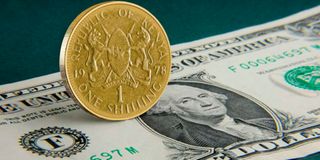Developing story: Iranian President Ebrahim Raisi confirmed dead in chopper crash
What does a weak shilling mean for the economy?

A record slump of Kenya shilling against the dollar and the sterling pound continued into the second half of the year, worsening the country’s debt service and import costs.
The shilling continued its downward slide, trading above 150 to the US dollar this week. This despite the official exchange rate posted by the Central Bank being Sh141.45 to the dollar.
The widening gap between the market rate and the official rate is reflective of the adverse market conditions. Some experts are now predicting it could go as low as Sh170 to the dollar by year end.
It is not that these experts are overly pessimistic or pro opposition, out to “sabotage” the economy as government hawks are bound to say.
Rather, they are observing the trends of imports, exports, diaspora remittances and portfolio flows, all of which determine the rate of exchange between the shilling and the dollar. The exchange rate is, after all, a price. It reflects our demand for, and supply of, dollars.
That demand arises because we are importing goods and services, whose payment is in dollars. That is why for example, some clever government folks came up with a government to government fuel import scheme that was supposed to postpone our demand for dollars (to pay for the oil) for six months! But I think they forgot that postponing a payment does not do away with it.
We get dollars from the sale of goods, like tea, coffee, avocado and macadamia. We also get dollars from the sale of services, like tourism, and digital content. Further, Kenyans working abroad regularly send money home, and investors buy stocks and bonds in the Nairobi securities exchange.
Lest you are tempted to fall into the current national pastime of blame game, and start looking for who is responsible for getting us into this problem, let us set the record straight. For the last 25 years, we have always had a trade deficit. That is, we import more that we export.
In the last 12 months for example, the nation’s monthly import bill has been an average of Sh206 billion, while we have been exporting Sh76.2 billion, resulting in a monthly deficit of Sh130 billion. For the year to June 2023 alone, this works out to Sh1.56 trillion.
You might be asking yourself by now, that if we have been going on like this for the last 25 years how come the shilling did not tank before? Let us examine this briefly.
First, the reason IMF and other experts have always maintained that the shilling is over-valued is because of this continuous, persistent, trade deficit. The economic reasoning is that the shilling should weaken, to bring balance between the imports and exports. Many in government, current and past disagree, pointing with nostalgia when the British pound was twenty shillings.
Central bank on its part keeps official dollar reserves, and tracks how many months of import cover we have. When we don’t have enough dollars to cover our imports, we are forced to borrow from the IMF.
The shilling has, however, remained strong because the overall balance of payments (BOP) has regularly been positive. The balance of payments is the totality of trade account, and the capital account. The latter is the balance of diaspora remittances and inward portfolio flows, and outward flows when investors repatriate dividends or when they sell their holdings all together.
The overall balance of payments (BOP) for the 12 months to March 2023 was a positive US$2.1 billion (2% of GDP), while the trade deficit widened 10.4% in the 12 months to March to US 5.3 billion, but it is no worse than the US$5.4 billion of two years earlier.
But the positive BOP notwithstanding, the shilling has been under sustained negative sentiment, losing 20% against the US dollar in the 12 months.
This sentiment is likely to last through into next year. But it is more than sentiment. Diaspora remittances have slowed down. And investors are selling off their holdings of Kenyan stocks, and moving their monies to US$ assets because interest rates are comparatively high.
The weak shilling, is expected to have a positive impact on export earnings from agricultural exports and tourism. And it has. Average monthly exports are up by as much 14 per cent when you compare the last one year, with the previous twelve months.
Imports, despite being more expensive have not slowed down. The average monthly import bill has increased 4.4% during the year to June 2023, compared to the previous year.
In the 12 months to March 2023, the trade deficit was US$5.3 billion, up from US$4.8 billion the previous year. This widening deficit can be attributed to a higher import bill for petroleum products, which more than offsets the export earnings from key sectors such as tea and horticulture.
In addition, rising production costs, on account of high fuel and energy costs may dampen the expected surge in export earnings.
What does all this mean for Wanjiku? The prices of all the things we import will continue to rise. She can expect the price of petroleum to go higher yet, and with it the cost of transportation. She can expect the price of mutumba to go up. And she can expect the price of cooking fat and kerosene to go up.
Responding to this inflationary pressure, Central Bank, may result to the only tool they have, and increase the interest rates again. If that happens, Wanjiku can expect the cost of her loan to go higher still, forcing her to increase the prices of her wares.
The upward spiral of the cost of living will continue.
@NdirituMuriithi is an economist





